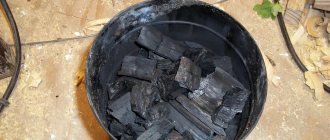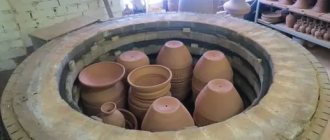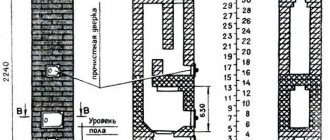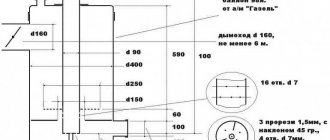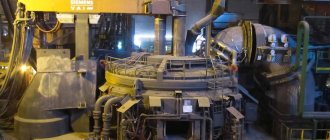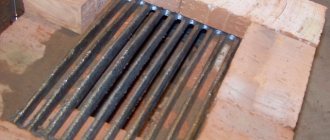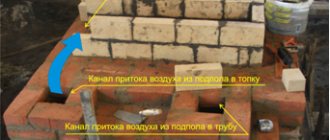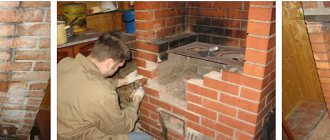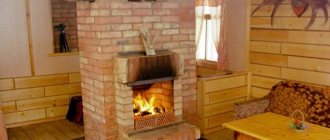Modern charcoal kilns help produce one of the most popular types of fuel - coal, a product obtained by pyrolysis (combustion without flame) without access to oxygen. As a result, the material contains a high concentration of hydrocarbons and has a microporous structure. In forest areas, it is a source of income for many entrepreneurs, because it is possible to assemble a furnace and organize production even on an ordinary plot outside the city. Finished coal is actively used in metallurgy, the chemical industry, animal husbandry, pharmacology, medicine, construction, and for heating houses.
Charcoaling process
Not only firewood of various types of wood is used as wood raw material, but also waste from woodworking or furniture production: knots, hemp, sawdust. Peat is used in marshy areas.
During the charring process, wood goes through three stages: pre-drying, thermal decomposition and cooling.
The initial drying and heating of the raw materials in the chamber occurs due to heat supplied from the outside. The heat generation process itself (chemical exothermic reaction) begins when the wood temperature reaches 280°C. Further heat supply is no longer needed.
After burning, the finished coal is cooled to a temperature at which spontaneous combustion of coal is impossible, that is, below 40°C.
During the first day, the mixture of flue gases and charring products still contains a lot of water vapor, which is released during the drying process. Then the mixture becomes drier and can be used as additional fuel in the same stove or, more efficiently, in a nearby one.
Properties of a natural fuel stove
As already mentioned, the combustion temperature of coal is quite high. With sufficient air supply to the firebox, it reaches 1000-1100 °C, so not every material can withstand such conditions for a long time.
For comparison: dry wood under identical circumstances can produce no more than 700 °C in the firebox, and even then very rarely. In addition, coal fuel is much higher in calories than firewood.
That is, when burning 1 kg of anthracite, almost 2 times more thermal energy is generated than from the same amount of wood, as shown in the table:
| Type of fuel | Calorific value | |
| MJ/kg | kW/kg | |
| Wood with a moisture content of 25% | 10,1 | 2,8 |
| Stone coals | 21,5 | 5,9 |
| Brown coals | 15,5 | 4,3 |
Previously, in old houses, heating stoves or slabs were made only of solid red brick. When constantly burning high-calorie coals, the masonry gradually began to crumble due to exposure to high temperatures, so the owners lined the inside of the firebox with thick steel soles from railway tracks to protect the walls.
At the moment, the problem of burning coal is solved much easier - with the help of fireclay bricks. The design of the furnace provides for lining the fuel chamber with fireclay stone grade ША, ШБ or ШВ to a thickness of a quarter or half a brick. This material can easily maintain temperatures of 1400 °C and short-term temperatures of up to 1650 °C.
There is another point: due to the higher calorie content than wood, a larger amount of heat is released, part of which goes with the combustion products into the chimney.
To avoid this, a more developed smoke circulation network is provided in the coal furnace, where flue gases have time to transfer heat to the brick walls, and not immediately fly out into the chimney.
Otherwise, this is an ordinary brick stove with all the advantages and disadvantages.
Coal burning equipment
To produce charcoal, charcoal kilns of various capacities are used. Such coal is obtained through the process of pyrolysis, that is, the wood is burned without access to oxygen.
Charcoal kilns for the production of charcoal are available as stationary and mobile.
Stationary equipment is used by fairly large manufacturers for the continuous process of pyrolysis of large volumes of wood.

Large stoves are much more productive than mobile ones; they can use several types of fuel, but they are subject to high environmental safety requirements.
Mobile kilns are low-capacity, small in size, and are used either where raw materials are available, such as logging sites, or where the final product is needed, such as construction sites.
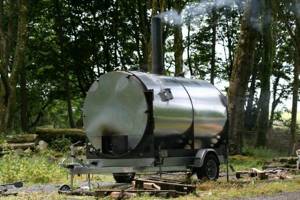
In mobile furnaces, the fuel is the same waste wood from which coal is produced.
If the furnace operates on waste, then the benefit is double, and coal is produced without additional fuel costs, and waste is processed, which would still have to be disposed of, costing money and time. This type of charcoal production is the cheapest.
Areas of application
The demand for this product is quite high, since, in addition to heating private houses, it can be used:
- in the production of electrodes, various paints, glass and crystal;
- for the production of silicon for semiconductors, boron, aluminum;
- in metallurgy - as a reducing agent;
- as a fertilizer;
- as an additive to pet food;
- when grinding and polishing parts used in printing;
- as an insulating material in construction;
- as a replacement for graphite in plastics production;
- in the production of smoke powder;
- in the production of brushes, resistances, contacts, which are installed in electrical and electric vacuum equipment;
- in the production of activated carbon - as a raw material.
The resin released during the production process is used to produce acetic acid for the food industry, methyl alcohol, solvents, rosin, and turpentine.
Continuous charcoal burning equipment
A separate group consists of charcoal kilns, in which flue gases from burning fuel enter the chamber, pass through the wood, acquire vapors and gases that are products of drying and charring of wood raw materials, and exit outside. In them, the pyrolysis process occurs most evenly, since the wood is in direct contact with the coolant supplied from below. But pyrogases contain high concentrations of chemical compounds that are products of wood decomposition, so additional equipment must be installed for beneficial use or combustion of pyrolysis by-products.
This is how continuously operating vertical retorts work, in the chamber of which wood is dried at the top, pyrolysis takes place in the middle layer, and coal is calcined and cooled at the very bottom.
Charcoal kilns with replaceable containers or retorts also operate continuously. The principle of operation of such installations is that each subsequent batch of raw materials is heated to the required temperature due to the exothermic reaction in the previous one.
In this case, the process of coal formation occurs in each retort independently of the others, and the furnace, into the firebox of which pyrolysis gases are discharged, is located separately from the replaceable chambers.
Retorts and chambers for pyrolysis are made of metal with thermal insulation.
When filling with coolant
There are only two known situations that require this technological operation:
- putting heating into operation (at the beginning of the heating season);
- restart after repair work.
Typically, coolant water is drained in late spring for two reasons:
- Water inevitably becomes contaminated with corrosion products (inside radiators, metal-plastic and polypropylene pipes are not susceptible to it). If you leave old water for the new season, you risk breaking the circulation pump with solid contaminants.
- Flooded systems of country houses that have not been started can “defrost” during a sudden cold snap - such cases are not uncommon. In this sense, antifreeze coolant is preferable. The high-quality composition has high anti-corrosion properties, increasing the drain interval to 5-6 years. There are known cases of uninterrupted heating operation with the same volume of antifreeze for 15-17 years. It is recommended to drain low-quality antifreeze after 2-3 years.
Batch cycle charcoal burning equipment
The simplest design of a charcoal kiln is an ordinary two-hundred-liter metal barrel into which wood is placed and set on fire. Additional heat is not supplied, and vapors are discharged through a special small hole. The production of low-quality coal, with a yield of less than fifteen percent, is dirty, but practically cost-free.
Today there are designs of charcoal kilns in which the walls of the chamber are heated by a coolant, from which the heat is transferred to the firewood in it. These are, as a rule, charcoal burning kilns of a periodic cycle, where the entire process of burning coal occurs at certain intervals: firewood is loaded, re-coalmed, the finished coal is unloaded, firewood is loaded again, and so on.
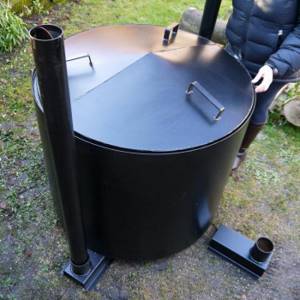
In mixed-action devices, wood is periodically loaded and finished coal is unloaded, but some part of the wood is always in the process of pyrolysis.
Stoves can also be made of metal or brick.
Conclusion
Charcoal is a sought-after raw material for many economic purposes and household needs of summer residents and lovers of outdoor recreation, and barbecue makers. The installation for its production will pay for itself quickly, it is unpretentious to use and has low energy consumption.
But you also need to remember the safety rules when working with charcoal kilns. All work should be carried out only in the open air, or in a room equipped with forced exhaust ventilation from a source of gas generation and combustion.
Modern charcoal kilns help produce one of the most popular types of fuel - coal, a product obtained by pyrolysis (combustion without flame) without access to oxygen. As a result, the material contains a high concentration of hydrocarbons and has a microporous structure. In forest areas, it is a source of income for many entrepreneurs, because it is possible to assemble a furnace and organize production even on an ordinary plot outside the city. Finished coal is actively used in metallurgy, the chemical industry, animal husbandry, pharmacology, medicine, construction, and for heating houses.
Three chamber charcoal kiln
The vapor-gas mixture, which is removed from the pyrolysis chamber, condenses as it cools. Pyrolysis liquid (liquid) and non-condensable gases, since they are not yet widely used, are used as additional fuel in the combustion chamber. The removal of by-products for afterburning is provided for by the design of the furnace. The effect of this design is not only in saving fuel, but also in protecting the environment.
Three-chamber charcoal kilns provide a continuous cycle of coal production. In each chamber, one of the stages of the cycle takes place separately, and the initial drying of the raw material occurs due to the heat that is obtained during the combustion of pyrolysis gases. In addition to saving fuel, such stoves have many other advantages. Since the loading of wood and the unloading of finished coal occur at different times, the operating personnel are more evenly loaded. The cost of a three-chamber oven is lower than a single-chamber oven of the same volume, and efficiency and service life are higher due to load distribution.
Such equipment is designed for long-term operation in large industries, and if it is equipped with a gas generator boiler, then sawdust and shavings can be used as fuel.
How to connect HDMI to VGA
→ How to connect HDMI to VGA
Users often need to connect two different connectors that transmit video. This usually concerns interfaces with different signals: one supports analog, and the other supports digital.
Interfaces
HDMI is a high definition multimedia interface. It is used to transmit video and audio signals. Most modern equipment has built-in HDMI: AV, electronics, computers and many others. The interface is reliable and future-proof because electronics manufacturers closely support it.
Video Graphics Array is a video interface that was used in monitors and graphics cards before the advent of HDMI. First released in 1987, the interface is outdated but still found on analog monitors. Despite its age, VGA is capable of supporting resolutions higher than FullHD, although the image will be fuzzy and blurry.
Story
Video Graphics Array is a 15-pin interface often called D-SUB. From the introduction of LCD monitors until the rise of LCD monitors, VGA was the most common input in computers. It is quite common on modern devices, as it is capable of supporting resolutions up to 2048x1536 and a screen refresh rate of 85 Hz.
The largest electronics manufacturers agreed in 2010 to get rid of VGA standards and switch to digital interfaces within five years. Despite this, VGA is still used. It occurs on outdated but working devices. In addition, manufacturers that did not participate in the agreement continue to equip their products with this interface. Therefore, users often need to know how to connect a VGA device to HDMI.
Reasons for connecting via an adapter
Many users change PC parts one by one, first purchasing a computer, then purchasing peripherals. Modern video cards from leading manufacturers do not have a VGA connector - only HDMI and DVI. On older monitors, on the contrary, there is only a VGA output.
In such a situation, the problem of connecting devices to each other arises. To solve this, an adapter is needed. Keep in mind that VGA is an analog connector, while HDMI and DVI are digital. To connect video cards RX 400 or GeForce 1000 and higher, use an active adapter - signal converter.
Advantages of the adapter
The converter is designed to connect devices with VGA output to computers with HDMI or DVI input. Adapters are the only way to create a working system without a clutter of wires or buying a new monitor. In addition, with their help you can connect not only a computer to a monitor, but also a TV or studio equipment with a screen.
Adapter selection
Modern video cards have digital inputs, but they can be connected to analog monitors. To do this, use an active adapter. The device helps convert digital images to analogue.
Before purchasing a converter you must:
- Inspect the video card and write down the connectors present on it. See what outputs are present in the monitor.
- Ask the store for availability of a certain converter. Usually there are active adapters only from VGA to DVI-D. In this case, you can connect VGA to HDMI using only two adapters.
- Keep in mind that the converter consumes electrical energy through the video card. To protect your device, it is advisable to purchase an adapter with an additional USB output.
When choosing, keep in mind that the cable size affects the image quality, reducing the latter as the length increases. Most digital interfaces transmit not only video, but also audio. Thanks to this, they can be connected to speakers or a TV, but you will need a special adapter model. The converters do not require configuration: just connect and start using.
Adapter types
The adapter is selected depending on the availability of certain connectors. If your monitor or video card only has a VGA interface, one part of the adapter must include the corresponding output. To connect, you will need a wire with two inputs: one to the monitor or graphics card, the second to the converter. Next to the VGA, a red and white RCA output is built in, which is used when connecting to a TV.
The opposite side of the adapter must contain a digital interface. If the connected device only has HDMI or DVI-D, an appropriate converter is required. In some cases, it is necessary to connect VGA to HDMI using a DVI-D converter, since there is no necessary one. In such a situation, you will need an inactive HDMI VGA adapter.
HDMI to VGA adapter
HDMI to VGA adapter (male HDMI to female VGA cable) HD1161 /VСonn/
Price: 600 rub.
The simplest device, model HD1161 , allows you to display an image on a monitor. It is a wire with an HDMI output, while VGA can be both an output and an input. Does not output sound, but has a low cost. Has a length of 15-20 cm
, which is increased with 2 HDMI wires of the required length.
Single chamber charcoal kiln
Charcoal can be produced in small quantities (up to 8 tons per month) in a single-chamber furnace. The full production cycle depends on the model of the device and can take 1-3 days.
Such a stove can be used in private households, in public catering establishments, for the purpose of recycling production waste and substandard products in small woodworking enterprises.

The production principle in them and large-sized industrial furnaces is no different. Single-chamber furnaces are usually smaller in size, they also contain less raw materials, but they also take up less space and are easy to transport if necessary.

The production of charcoal kilns for home use has long existed abroad. Grilled or barbecued dishes are prepared using environmentally friendly charcoal.
Where is charcoal used?
What is sandpaper: all types, features of production and use
The question often arises, where is charcoal used? In the distant past, this was the only source of fuel. In our time, it has not lost its position, and its scope of application has expanded significantly:
- Metallurgy
. The high carbon content makes it possible to use charcoal as a reducing agent, and the absence of sulfur and phosphorus guarantees the preservation of the necessary properties of the reduced materials. - Instrumentation
. Coal, which is obtained from soft wood, is used to make an anti-corrosion lubricant, which is needed for polishing and grinding various shapes and parts. - Construction
. Since this material absorbs odors well and is hygroscopic, coal is used as an insulator. - Animal husbandry
. This is an excellent feed additive that is introduced into the diet of calves, pigs, and birds. - Production of activated carbon
. It is used in many ventilation systems in order to trap volatile harmful impurities in the air. - Medicine
. Wood raw materials are used to make tablets and powders that help in the treatment of gastrointestinal disorders and poisoning.
Characteristics and design of charcoal kiln
Manufacturers of charcoal kilns, both foreign and domestic, indicate the working volume of one chamber and the total number of chambers in the kiln as the first characteristic. Then the volume of firewood with a given size and humidity that can be loaded into the oven at a time is usually indicated. This indicator is important for compliance with the next parameter - the duration in hours of the main working cycle.
To determine the operating efficiency of a particular model, two parameters are set for wood of the same species - the estimated amount of firewood loaded into the pyrolysis chamber and the yield of coal from it.
The last to be indicated are the overall dimensions of the stove and its weight. If the device is not intended to be transported, this data may not play a special role, but during transportation it may become decisive.
As a rule, a household single-chamber stove is a metal barrel laid with a slight slope or installed on supports with a firebox built into the lower part.
The firebox itself, the stove body, the pipe box and the hatch door are made of steel with a thickness of at least 3 mm, and the outer lining is 1 mm.
The double-sided welds that connect the body shells are reinforced with bandages, which are made from a rectangular pipe, giving the structure rigidity and additional strength if pressure suddenly increases in the container.
To reduce heat loss, thermal insulation material is laid between the chamber body and the outer casing. This measure increases the efficiency of the furnace. The inside walls of the firebox are lined with refractory bricks.
Devices for afterburning charring products can be supplied separately.
How coal is made from wood in factories: technological aspects
Charcoal is made from wood through pyrolysis. This is a process involving the dry distillation of raw materials. In other words, during production, decomposition of organic carbon compounds occurs under the influence of high temperatures (with limited or no oxygen at all).
The low air content (or its complete absence) during the production of the product is explained by the prevention of combustion. Therefore, the flame does not arise due to combustion, but due to gases formed when heated to 500°C.
For pyrolysis, retort furnaces (pyrolysis boilers) of a stationary or mobile type are used, which have a pyrometer that allows you to regulate the temperature. Raw materials are placed into the loading space manually or automatically.
However, first the wood is unloaded into a designated area and sorted. If wood raw materials are purchased not crushed, they are chopped into firewood.
- The first stage involves drying. Then the temperature is not raised above 150°C.
- When excess moisture leaves the wood material, the temperature is increased and proceed to the next step. Heat is generated in the upper chamber of the oven. Under its action, wood is burned, wood gas is generated, which moves to the nozzle to mix with secondary air. As a result of these processes, burnt, dry coal is formed.
- Next you need to calcinate it. This will remove resin and unnecessary gases.
- The wood product is then unloaded and allowed to cool.
- Then crushed, briquette products are made from it.
A diagram of the technological process that takes place over 16-20 hours, during which coal is made, is shown in the figure:
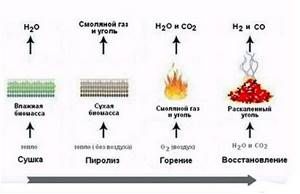
The raw materials are:
- decks;
- hemp;
- branches;
- measles;
- wood chips;
- whips;
- waste generated during the manufacture of furniture,
- logs;
- sawdust;
- wood preparations;
- mouthguards;
- peat.
The purchase of consumables is organized from forestry departments.
To produce 1 ton of coal, you will have to spend up to 8 cubic meters. m. birch. If soft hardwoods are used, the consumption is higher - up to 12 cubic meters. m. The factories produce 3 grades of coal: A, B, C.
Safety rules for making charcoal.
According to safety rules, only produced coal, the volume of which exceeds 100 cubic meters. dm, may spontaneously ignite. Because of this, it is necessary to take measures to prevent spontaneous combustion.
Many entrepreneurs who understand how charcoal is made, unfortunately, do not comply with these requirements and do not protect their products from contact with the oxidizing agent. Allowing the accumulation of coal dust is also considered a big mistake.
When workers make charcoal, labor safety rules R O-00-97 must be observed, which you can read here - https://ohranatruda.ru/ot_biblio/norma/252437
To transport wood products, you need to use steel barrels, craft, paper, and polypropylene bags. Coal is stored in closed warehouses and special bunkers to prevent the ingress of precipitation.
Delivery of goods is carried out in bulk or in packaged form using trucks and covered wagons.
DIY charcoal stove
A barrel on a stand is the simplest design, but for greater efficiency and fire safety, the barrel must be installed on a non-combustible base or buried in a hole.
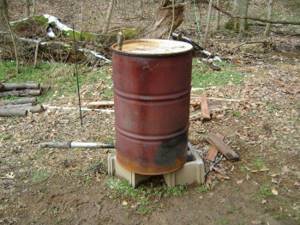
You can make your own charcoal kilns from brick or metal. The drawing can be found on the Internet, as well as fairly detailed descriptions. True, you need to understand that the quality of a homemade stove and the final product is much lower, and there will not be large volumes of coal.
You can make a coal pit at your summer cottage, or you can build a charcoal kiln out of barrels. To do this, you need to dig a hole of such a diameter that a barrel can fit into it, which also needs to be lined with bricks, cut a hole in the bottom of the barrel with a diameter of approximately 100 mm and place it in the hole with the hole down.
Then you need to line the barrel with bricks, close the cracks at the top with some fireproof material, and insulate the top bottom with mineral wool. That's all, you can get your own coal for the fireplace and barbecue.
The double barrel design is more efficient and reliable. A container, which is half the volume, is placed in a larger one, filled with firewood and tightly closed with a lid, and fine wood waste is poured into the space between the walls and set on fire, then the large barrel is also closed with a lid into which a pipe is inserted. But both of these stoves are only suitable for outdoor use and far enough away from them.
In the hole
At some distance from any buildings, a hole is dug in the soil for this method of charcoal burning. For a couple of bags of coal, a hole half a meter deep and 80 centimeters in diameter will be enough.
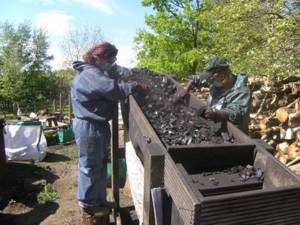
The bottom of the pit should be thoroughly trampled manually or with a special device. After compaction, a fire of brushwood is lit at the bottom of the pit, from time to time throwing small, but not too small, firewood into it.

You should not allow tree bark to get into the fire, as its combustion produces a large amount of smoke, which will negatively affect the quality of the final product.
Each new portion of coal should be added at the moment when the previous one has already burned well and decreased in volume.
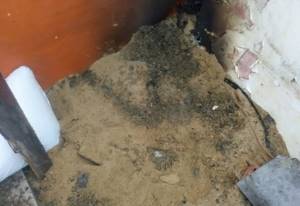
After placing a new portion, the contents of the pit are compacted, and the operations are repeated until the recess is filled to the brim.

